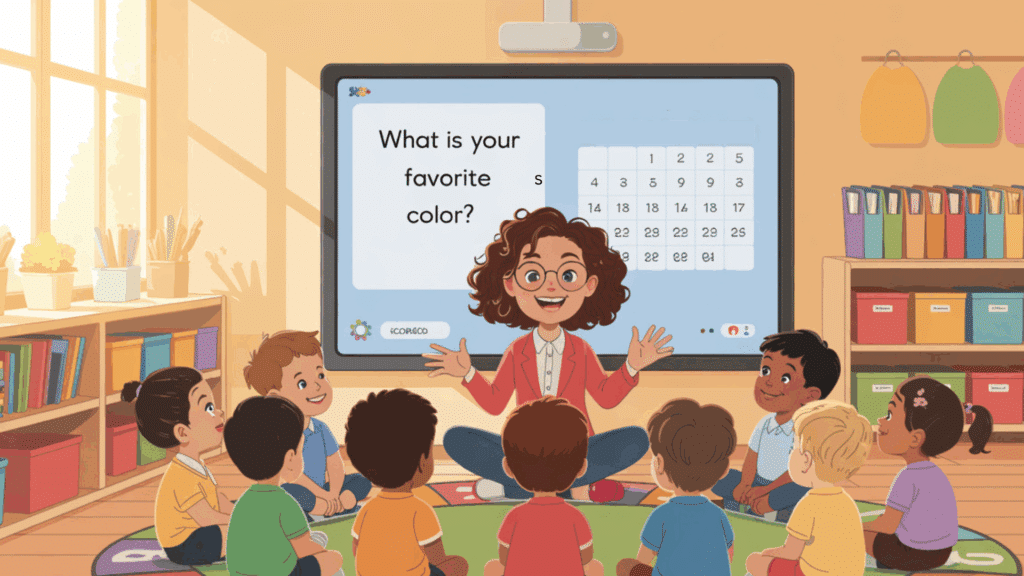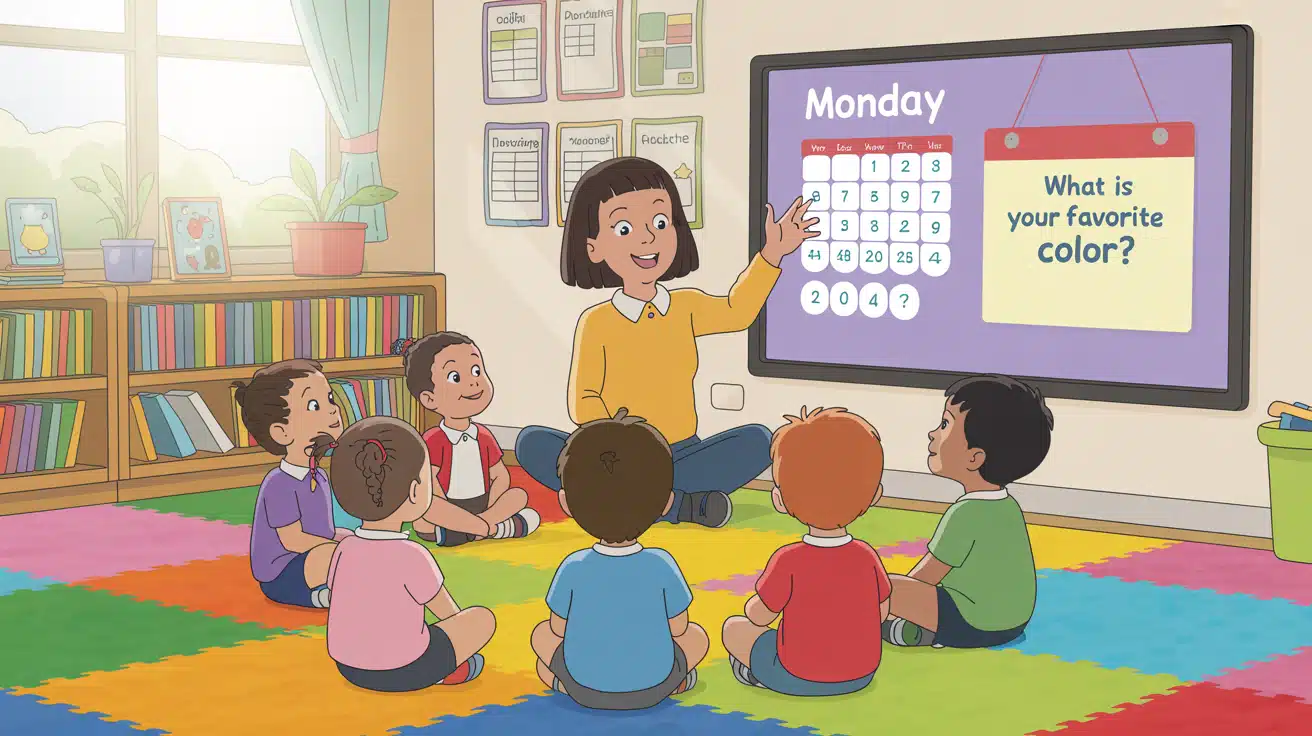You know those first few minutes of the school day? They can set the tone for everything that follows if you’re teaching young kids; starting strong matters.
A morning meeting for kindergarten helps you bring calm, connection, and structure right from the start. It gives your students a clear path and a warm place to land each morning.
In this blog, you’ll find simple ways to plan your meeting, easy questions to ask, and fun ideas to keep kids involved. You’ll also see how to manage routines without stress.
Want mornings that run smoother and help your class feel like a team? Keep reading.
The 4 Key Parts of a Successful Morning Meeting
Each morning meeting includes four key steps that help create a balanced start to the day. These parts work together to build connections, support classroom habits, and help students feel ready to learn.
1. Greeting
The greeting sets a friendly tone and helps everyone feel seen and welcomed. It can be as simple as a wave, a cheerful “good morning,” or a quick name game.
This moment allows students to practice respectful social interaction as they start the day with a smile. You can change up greetings each week to keep things fresh but familiar. The goal is to create a space where every child feels noticed, valued, and ready to be part of the group.
2. Sharing
Sharing gives students a chance to speak and listen in a structured way. One child might tell a short story, answer a question, or talk about something they love. Others listen respectfully and may ask kind questions or offer support.
This helps students build language skills and teaches them how to take turns, express ideas, and relate to others. Sharing also helps build trust in the classroom, which leads to stronger friendships and better group learning.
3. Group Activity or Game
This part adds fun and energy to the morning meeting. The activity could be a short movement game, a brain teaser, or a classroom chant.
Games help build teamwork and teach kids how to follow rules, wait their turn, and enjoy group fun. It’s also a way to wake up sleepy minds and bodies so kids feel more focused.
Activities should be simple, quick, and matched to the age and energy level of the class that day.
4. Morning Message or Calendar
The final part helps guide the day ahead. Teachers might read a short note, talk through the calendar, or give reminders about special events.
Some use charts or digital slides to keep it visual and clear. This part builds literacy, math, and time skills in a real-world way.
Students know what to expect, which reduces confusion and sets a calm, clear tone. You can also pair this time with quiet morning work for kindergarten to ease the transition into learning.
Morning Meeting Questions to Start Conversations
Asking the right questions helps students open up and connect with others. These prompts guide short talks that build confidence, support listening skills, and create a caring classroom where every voice matters.
Daily Check-in Prompts
These simple questions help students reflect on how they’re feeling. They can be used as a quick mood check or to start a short class discussion. Great for building emotional awareness.
Examples:
- “How do you feel today?”
- “What color matches your mood?”
- “What kind of day are you hoping for?”
- “What’s something you’re excited about today?”
Kindness & Gratitude Prompts
These prompts help kids think about others and practice thankfulness. They support a caring tone and remind students to notice the good in themselves and their classmates.
Examples:
- “What made you smile yesterday?”
- “What’s one nice thing you can do today?”
- “Who helped you recently?”
- “What are you thankful for this morning?”
Social-Emotional Prompts
These questions help children name feelings and build healthy ways to handle them. They’re great for practicing empathy, managing emotions, and learning how to solve small problems.
Examples:
- “What can you do when you feel sad?”
- “How do you help a friend who’s upset?”
- “What does being brave look like?”
- “When do you feel proud of yourself?”
Fun Morning Meeting Activities Kids Love

Adding play to your morning meeting keeps students interested and helps them feel part of a team.
These short, engaging activities support turn-taking, focus, cooperation, and energy balance, all while bringing fun into the classroom.
Rotate through different types to match your students’ needs and the pace of the day.
Movement Games (Simon Says, Freeze Dance)
These activities are great for waking up sleepy bodies and getting the wiggles out. Games like Simon Says boost listening skills and self-control, while Freeze Dance adds music and joy to the start of the day.
They’re simple to lead, require little prep, and help students start the morning with smiles and energy.
Circle Time Games (Silent Ball, Would You Rather)
Circle games create a calm, shared focus. Silent Ball promotes quiet coordination and mindful movement.
Would You Rather encourages light conversation and helps students make choices and express opinions. These are especially helpful on slower mornings or rainy days when calm connection is key.
Partner or Team Games (Greeting Scavenger Hunt, Mirror Game)
These games encourage teamwork in small groups or pairs. In the Greeting Scavenger Hunt, students find classmates using fun clues like “find someone who has a pet.”
Mirror Game promotes attention and trust as one student gently mimics another’s movements. These activities build confidence and connection in a low-pressure way.
Keeping It Fresh Every Day
Even routines need a little change to stay interesting. Switching up your morning meeting activities and prompts keeps students engaged while still giving them the comfort of structure and predictability.
Weekly Themes
Themes give your meetings a focus and make planning easier. Each week can highlight a topic like animals, friendship, or community helpers. Activities, questions, and books can match the theme, adding fun and variety.
Examples:
- Animal Week
- Friendship Week
- Color Week
- Helping Hands Week
Seasonal Adjustments
Adjust your meeting style according to the weather or the time of year. Use calm games and cozy chats on rainy days. Add songs, stretching, or nature themes when it’s warm and sunny. This keeps things fresh and connected to what’s happening around the students.
Examples:
- Story circle on cold mornings
- Movement games outside when warm
- Thankful themes in fall
- Weather talk in spring
Rotating Question Formats
Changing how you ask questions can bring new life to your routine. Try using mystery boxes with surprise objects, photo cards, or simple props, such as puppets. These add visual interest and help students focus.
Examples:
- Pull a photo card and ask, “What do you see?”
- Use a puppet to ask a question
- Hide a toy and ask clues to guess it
- Use dice or spinners to pick today’s prompt
Digital Slides That Support a Smooth Morning Routine
Using digital slides can help you stay organized and make morning meetings run more smoothly. They add structure, keep kids engaged, and are easy to change as your needs shift throughout the year.
Where to Find Ready-Made Slides
There are many teacher-friendly places to find ready-made slide sets for your meetings. Websites like Teachers Pay Teachers, Simply Kinder, and other blogs often offer themed slides for each month.
These can include calendars, daily questions, task checklists, and more. Many of these resources are easily accessible with a Smartboard or projector, making the morning routine clear and straightforward for students to follow.
How to Create Your Own in Google Slides or PowerPoint
You can make your own slides with just a few basic steps. Use Google Slides or PowerPoint to build a morning routine deck. Start with a calendar page, add daily questions, and include simple icons or shapes for visual support.
Keep fonts large and images clear. Once your basic layout is set, copy the deck for each week or month and swap out key parts. This helps you stay flexible while maintaining neat and consistent slides.
Custom Weekly Slide Planner (Digital-Only Option)
Offer your own version of a digital weekly planner using slides. Each day’s slide can include:
- Date and calendar info
- Morning question
- Greeting choice
- Group activity of the day
This setup gives your students a clear view of what’s coming and keeps your meeting on track. You can even share it with families to build home-school connections. Updating slides weekly keeps things fresh while staying easy to manage.
Conclusion
If you’ve been looking for a better way to begin the day, a morning meeting for kindergarten might be your answer. It brings focus, friendship, and steady habits into your classroom, all before the first lesson even starts.
Now that you’ve seen how to structure it, what to ask, and how to keep it fresh, you can build a meeting that fits your style and supports your students.
Give it a try, and notice the change it brings. Ready for more helpful ideas like this? Take a look at the rest of our classroom tips and routines, you’ll be glad you did.




